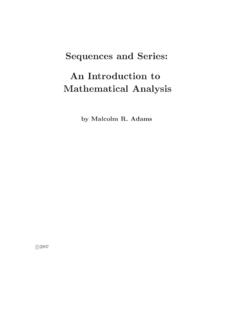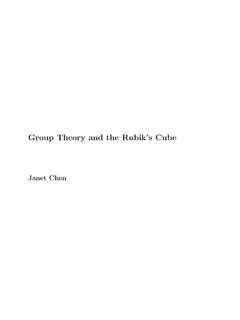Transcription of Advanced Complex Analysis - Harvard University
1 Advanced Complex AnalysisCourse Notes Harvard University Math 213aC. McMullenJanuary 16, 2023 Contents1 Basic Complex Analysis ..22 The simply-connected Riemann surfaces .. 393 Entire and meromorphic functions .. 594 Conformal mapping .. 815 Elliptic functions and elliptic curves .. 109 ForwardComplex Analysis is a nexus for many mathematical fields, including:1. Algebra (theory of fields and equations);2. Algebraic geometry and Complex manifolds;3. Geometry (Platonic solids; flat tori; hyperbolic manifolds of dimen-sions two and three);4. Lie groups, discrete subgroups and homogeneous spaces ( (Z);5.)
2 Dynamics (iterated rational maps);6. Number theory and automorphic forms (elliptic functions , zeta func-tions);7. Theory of Riemann surfaces (Teichm uller theory, curves and their Ja-cobians);8. Several Complex variables and Complex manifolds;9. Real Analysis and PDE (harmonic functions , elliptic equations anddistributions).This course covers some basic material on both the geometric and analyticaspects of Complex Analysis in one :Background in real Analysis and basic differential topology(such as covering spaces and differential forms), and a first course in (These exercises are review.)1. LetT R3be the spherical triangle defined byx2+y2+z2= 1 andx,y,z 0.
3 Let =z dxdz.(a) Find a smooth 1-form onR3such that =d .(b) Define consistent orientations forTand T.(c) Using your choices in (ii), compute T and T directly, andcheck that they agree. (Why should they agree?)12. Letf(z) = (az+b)/(cz+d) be a M obius transformation. Show thenumber of rational mapsg: C Csuch thatg(g(g(g(g(z))))) =f(z)is 1, 5 or . Explain how to determine which alternative holds for Let anznbe the Taylor series for tanh(z) atz= 0.(a) What is the radius of convergence of this power series?(b) Show thata5= 2/15.(c) Give an explicit value ofNsuch that tanh(1) and N0anagreeto 1000 decimal places.
4 Justify your Letf:U Vbe a proper local homeomorphism between a pair ofopen setsU,V C. Prove thatfis a covering map. (Herepropermeans thatf 1(K) is compact wheneverK Vis compact.)5. Letf:C Cbe given by a polynomial of degree 2 or more. LetV1={f(z) :f (z) = 0} Cbe the set of critical values off, letV0=f 1(V1), and letUi=C Vifori= 0,1. Prove thatf:U0 U1is a covering Give an example whereU0/U1is a normal (or Galois) covering, ( 1(U0)) is a normal subgroup of 1(U1).1 Basic Complex analysisWe begin with an overview of basic facts about the Complex plane andanalytic Complex numbers will be denotedC.
5 We let ,Hand Cdenote the unit disk|z|<1, the upper half plane Im(z)>0, and theRiemann sphereC { }. We writeS1(r) for the circle|z|=r, andS1forthe unit circle, each oriented counter-clockwise. We also set = {0}andC =C {0}. Algebraic and analytic functionsThe Complex numbers are formally defined as the fieldC=R[i], wherei2= 1. They are represented in the Euclidean plane byz= (x,y) =x+ are two square-roots of 1 inC; the numberiis the one with positiveimaginary important role is played by the Galois involutionz7 z. We define|z|2=N(z) =zz=x2+y2. (Compare the case of a real quadratic field,whereN(a+b d) =a2 db2gives anindefiniteform.)
6 Compatibility of|z|with the Euclidean metric justifies the identification ofCandR2. We alsosee thatzis a field: 1/z=z/|z|.It is also convenient to describe Complex numbers by polar coordinatesz= [r, ] =r(cos +isin ).Herer=|z|and = argz R/2 Z. (The multivaluedness of argzrequirescare but is also the ultimate source of powerful results such as Cauchy sintegral formula.) We then have[r1, 1][r2, 2] = [r1r2, 1+ 2].In particular, the linear mapsf(z) =az+b,a6= 0, ofCto itself, preserveangles and formula should be provedgeometrically: in fact, it is a consequenceof the formula|ab|=|a||b|and properties of similar triangles.
7 It can thenbe used to derive the addition formulas for sine and cosine (in Ahflors thereverse logic is applied).Algebraic critical feature of the Complex numbers is thatthey arealgebraically closed; every polynomial has a root. (A proof will bereviewed below).Classically, the Complex numbers were introducing in the course of solv-ingrealcubic equations. Staring withx3+ax+b= 0 one can make aTschirnhaus transformation soa= 0. This is done by introducing a newvariabley=cx2+dsuch that yi= y2i= 0; even whenaandbare real,it may be necessary to chooseccomplex (the discriminant of the equationforcis 27b2+ 4a3.)
8 It is negative when the cubic has only one real root;this can be checked by looking at the product of the values of the cubic atits max and an open set inCandf:U Ca sayfisanalyticiff (z) = limt 0f(z+t) f(z)t3exists for allz U. It is crucial here thattapproaches zero through arbitraryvalues inC. Remarkably, this condition implies thatfis a smooth (C )function. For example, polynomials are analytic, as are rational functionsaway from their that anyreal linearfunction :C Chas the form (v) =av+ condition of analytic says thatDfz(v) =f (z)v; in other words, thevpart is make this point systematically, for a generalC1functionF:U Cwe definedFdz=12(dFdx+1idFdy)anddFdz=12(dFd x 1idFdy) We then haveDFz(v) =dFdzv+ can also write Complex -valued 1-formdFasdF= F+ F=dFdzdz+dFdzdzThusFis analytic iff F= 0; these are note that (d/dz)zn=nzn 1.
9 A polynomialp(z,z) behaves as if thesevariables are of analytic and rational addition and multipli-cation we obtain naturally the polynomial functionsf(z) = n0anzn:C C. The ring of polynomialsC[z] is an integral domain and aunique factorization domain, sinceCis a field. Indeed, sinceCisalgebraically closed, fact every polynomial factors into linear is useful to add the allowed value to obtain the Riemann sphere C=C { }. Then rational functions (ratiosf(z) =p(z)/q(z) of rel-atively prime polynomials, with the denominator not identically zero)determine rational mapsf:C C. The rational functionsC(z) arethe same as the field of fractions for the domainC[z].
10 We setf(z) = ifq(z) = 0; these points are called the rational and polynomial functions ,the analytic functions includealgebraicfunctions such thatf(z) = z2+ 1. A general algebraic functionf(z) satisfiesP(f) = N0an(z)f(z)n=0 for some rational functionsan(z); these arise, at least formally, when4one forms algebraic extension ofC(z). Such functions are generallymultivalued, so we must choose a particular branch to obtain an ana-lytic functions also arise when one solvesdifferential equations. Even equations with constant coefficients, likey +y= 0, can give rise to transcendental functions such as sin(z),cos(z) andez.











